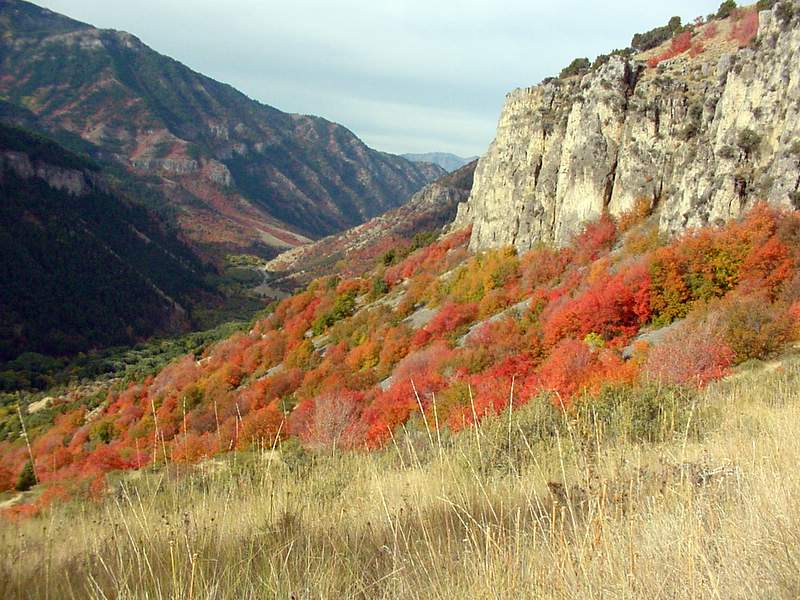
Courtesy & Copyright 2007 Linda Kervin
 Fall color in Logan Canyon
Fall color in Logan Canyon
Courtesy & Copyright 2007 Linda Kervin
In autumn, the days shorten noticeably and chilly dawns become the norm across most of Utah. Leafy plants now prepare for winter. Their summer of intense metabolic activities gradually give way to winter’s dormancy. Photosynthesis and respiration shut down as nutrients and sugars are withdrawn from leaves, to be shunted to the stem and roots for storage. But how do they anticipate the change in seasons so that they are ready for the rigors of winter?
Photosynthetic plants have a diverse array of pigments that they use to capture energy from most of the spectrum of visible sunlight. Chlorophyll is the most abundant, but its light gathering effectiveness is limited to a narrow band of the light spectrum. Plants employ many additional pigments to capture the energy available from other wavelengths of sunlight. These accessory pigments are brilliantly colored but masked by the sheer abundance of green chlorophyll.
One of these pigments, phytochrome, serves as a timekeeper for the plant. When phytochrome absorbs energy in the red band of sunlight, it helps to activate a number of developmental processes in the plant. As the nights lengthen in the fall, there are fewer hours of sunlight to activate the phytochrome and so it transforms to inhibit those same developmental processes.
One result is that chlorophyll is broken down and its components are moved to storage for use in the following spring. Essential nutrients, such as nitrogen and phosphorus, are likewise withdrawn from foliage for later use. With chlorophyll gone, the other colorful leaf pigments are revealed. Now maples, aspens, sumacs and more blaze for a few weeks of riotous glory.
This is Linda Kervin for Bridgerland Audubon Society.
Credits:
Photos: Courtesy & Copyright Linda Kervin
Theme: Courtesy & Copyright Don Anderson as performed by Leaping Lulu
Text: Linda Kervin and Jim Cane, Bridgerland Audubon Society
Voice: Linda Kervin
Additional Reading:
Linda Kervin’s pieces on Wild About Utah
Chemistry of Autumn Leaf Color, How Fall Colors Work, About.com: Chemistry, https://chemistry.about.com/library/weekly/aa082602a.htm
Why Do Leaves Change Color in the Fall?, Anne Marie Helmenstine, Ph.D., About.com: Chemistry, https://chemistry.about.com/od/howthingsworkfaqs/f/fallleafcolor.htm
“Autumn: a season of change” (2000) by Peter J. Marchand, https://www.amazon.com/Autumn-Season-Peter-J-Marchand/dp/0874518709
Where to see autumn leaves in Utah:
- U.S. 89, Logan Canyon, Brigham City to Logan, Logan to Bear Lake
- State Route 39, Monte Christo Summit, east of Huntsville
- State Route 190, Big Cottonwood Canyon, east of Salt Lake City, including Guardsman Pass
- State Route 210, Little Cottonwood Canyon, east of Salt Lake City
- State Route 92, the Mount Timpanogos loop a.k.a. the Alpine loop, north, east of Provo
- State Route 150, the Mirror Lake road, east of Kamas
- U.S. 40, Daniels Summit, east of Heber City
- Vernal, Red Cloud Loop (See Dinoland.com)
- Flaming Gorge – Unitas, State Route 191 and State Route 44
- State Route 132 Payson to Nephi, the Nebo Loop
- State Route 31, the Wasatch Plateau, east of Fairview
- State Route 12, over Boulder Mountain, between Torrey and Boulder (likely the most spectacular of all)
- The La Sal Mountain loop, east of Moab
- The Abajo Mountain loop, west of Monticello
- The canyons of the Escalante River, Grand Staircase-Escalante National Monument, southeast of Escalante
List sources:
Aspens and Fall Foliage in Utah, Jeffrey Otis Schmerker, 2001, https://www.utah.com/schmerker/2001/fall_foilage.htm
Ogden Valley Business Association, https://www.utahfallcolors.com
Fall Colors Tour, Utah in the Fall is a blast of color!, https://www.utah.com/byways/fallcolorstour.htm
National Forest Fall Color Hotline, 1-800-354-4595,https://www.fs.usda.gov/detail/r4/recreation/?cid=fsbdev3_016189
